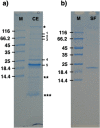Isolation and characterization of a main porin from the outer membrane of Salinibacter ruber
- PMID: 36229623
- PMCID: PMC9701654
- DOI: 10.1007/s10863-022-09950-7
Isolation and characterization of a main porin from the outer membrane of Salinibacter ruber
Abstract
Salinibacter ruber is an extremophilic bacterium able to grow in high-salts environments, such as saltern crystallizer ponds. This halophilic bacterium is red-pigmented due to the production of several carotenoids and their derivatives. Two of these pigment molecules, salinixanthin and retinal, are reported to be essential cofactors of the xanthorhodopsin, a light-driven proton pump unique to this bacterium. Here, we isolate and characterize an outer membrane porin-like protein that retains salinixanthin. The characterization by mass spectrometry identified an unknown protein whose structure, predicted by AlphaFold, consists of a 8 strands beta-barrel transmembrane organization typical of porins. The protein is found to be part of a functional network clearly involved in the outer membrane trafficking. Cryo-EM micrographs showed the shape and dimensions of a particle comparable with the ones of the predicted structure. Functional implications, with respect to the high representativity of this protein in the outer membrane fraction, are discussed considering its possible role in primary functions such as the nutrients uptake and the homeostatic balance. Finally, also a possible involvement in balancing the charge perturbation associated with the xanthorhodopsin and ATP synthase activities is considered.
Keywords: Carotenoids; Cell envelope; Cryo-EM; Halophile bacteria; Mass spectrometry; Outer membrane; Outer membrane proteins; Salinibacter ruber.
© 2022. The Author(s).
Conflict of interest statement
The authors declare that they have no competing interests.
Figures




Similar articles
-
Salinibacter: an extremely halophilic bacterium with archaeal properties.FEMS Microbiol Lett. 2013 May;342(1):1-9. doi: 10.1111/1574-6968.12094. Epub 2013 Feb 25. FEMS Microbiol Lett. 2013. PMID: 23373661 Review.
-
Unveiling the critical role of K+ for xanthorhodopsin expression in E. coli.J Photochem Photobiol B. 2024 Sep;258:112976. doi: 10.1016/j.jphotobiol.2024.112976. Epub 2024 Jul 2. J Photochem Photobiol B. 2024. PMID: 39002191
-
Bacterioruberin and salinixanthin carotenoids of extremely halophilic Archaea and Bacteria: a Raman spectroscopic study.Spectrochim Acta A Mol Biomol Spectrosc. 2013 Apr;106:99-103. doi: 10.1016/j.saa.2012.12.081. Epub 2013 Jan 8. Spectrochim Acta A Mol Biomol Spectrosc. 2013. PMID: 23376264
-
Femtosecond carotenoid to retinal energy transfer in xanthorhodopsin.Biophys J. 2009 Mar 18;96(6):2268-77. doi: 10.1016/j.bpj.2009.01.004. Biophys J. 2009. PMID: 19289053 Free PMC article.
-
The microbiology of red brines.Adv Appl Microbiol. 2020;113:57-110. doi: 10.1016/bs.aambs.2020.07.003. Epub 2020 Aug 17. Adv Appl Microbiol. 2020. PMID: 32948267 Review.
References
Publication types
MeSH terms
Substances
Supplementary concepts
Grants and funding
LinkOut - more resources
Full Text Sources

